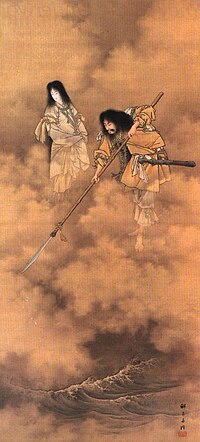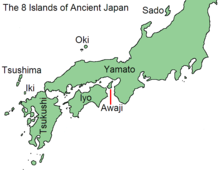Kuniumi

In Japanese mythology, the creation of Japan (国産み, Kuniumi, lit. "birth or formation of the country") is the traditional and legendary history of the emergence of the Japanese archipelago as narrated firsthand in the Kojiki and Nihon Shoki. According to this legend, after the creation of Heaven and Earth, the gods Izanagi and Izanami were given the task of forming a series of islands that would become what is now Japan. In Japanese mythology these islands make up the known world. The creation of Japan is followed by the creation of the gods (kamiumi).
Creation story
According to the Kojiki
After the formation of Heaven and Earth, the latter was still a soft mush. The gods Kotoamatsukami that had arisen after this event met to discuss the fate of the Earth. They decided to delegate the gods' youngest couple, Izanagi and Izanami, with a venerable mandate and gave them a naginata called Amenonuhoko covered with precious stones. The two deities then went to the bridge between heaven and earth called Ame-no-ukihashi (天浮橋) and started to churn the chaotic mass with the naginata. When drops of salty water fell from the tip, they formed into the first island, Onogoroshima. In forming this island, both gods came down from heaven, and spontaneously built a heavenly pillar called Ame-no-mihashira and a hall of eight fathom on it.[1][2]
Later, quoting the Kojiki, both held a conversation:[2]
How has your body been made?[nb 1]
Izanagi
My body is completely formed, but there is a part that has not grown and is closed.[nb 2]
Izanami
Also my body is fully formed, but I have a part that has grown too much. So, if I put there the part of my body that has grown too much, we will procreate the land. What better way to procreate?[nb 3]
Izanagi
Izanami accepted the offer and Izanagi proposed that both should circle around the column Ame-no-mihashira in opposite directions, Izanami going right and Izanagi left and on meeting each other would perform sexual intercourse. However when they met on the other side of the pillar, Izanami was the first to speak, saying: "Oh, indeed you are beautiful and kind youth!", to which Izanagi replied: "Oh, what a most beautiful and kind youth!". Izanagi then rebukes Izanami saying: "It is wrong for the wife to speak first.".[2]
However they mated anyway and later fathered a child Hiruko (lit. "leech child), who was placed in a reed boat dragged by the current and would later become the Japanese god Ebisu. Afterwards they gave birth to Ahashima (淡島, lit. "island of foam"). Both Hiruko and Ahashima are not considered legitimate children of Izanagi and Izanami.[2]
Izanagi and Izanami spoke about the problem they are having to have fathered badly-formed children and decided to consult the primordial gods at Takamagahara. The gods, through divination, responded that the reason for the problem is because the woman spoke first during the ceremony. So the couple returned to Onogorashima, they go around the pillar again and on meeting, Izanagi was the first to speak followed by Izanami. When finished they perform the union successfully and start to procreate the land.[3]
Birth of the islands
According to the legend, the formation of Japan started with the procreation of eight large islands by Izanagi and Izanami. In order of birth these islands are the following:[3]

- Ahaji-no-ho-no-sawake-no-shima (淡道之穂之狭別島): currently, Awaji Island;
- Iyo-no-futana-no-shima (伊予之二名島): currently, Shikoku. This island had a body and four faces. The names of the faces are as follows:
- Ehime (愛比売): Iyo Province;
- Iyorihiko (飯依比古): Sanuki Province;
- Ohogetsuhime (大宣都比売): Awa Province;
- Takeyoriwake (建依別): Tosa Province.
- Oki-no-mitsugo-no-shima (隠伎之三子島): today, Oki Islands. Dubbed Ame-no-oshikorowake (天之忍許呂別);
- Tsukushi-no-shima (筑紫島): today, Kyūshū. This island had a body and four faces. The names of the faces are as follows:
- Shirahiwake (白日別): Tsukushi Province;
- Toyohiwake (豊日別): Toyo Province;
- Takehimukahitoyojihinewake (建日向日豊久士比泥別): Hi Province;
- Takehiwake (建日別): Kumaso.
- Iki-no-shima (伊伎島): today, Iki Island. Dubbed Amehitotsubashira (天比登都柱);
- Tsu-shima (津島): today, Tsushima Island. Dubbed Ame-no-sadeyorihime (天之狭手依比売);
- Sado-no-shima (佐度島): today, Sado Island;
- Ohoyamatotoyoakitsu-shima (大倭豊秋津島): today, Honshu. Dubbed Amatsumisoratoyoakitsunewake (天御虚空豊秋津根別).
Traditionally these islands are known as Ōyashima (lit. eight large islands) and as a whole are what is currently known as Japan. In the myth neither Hokkaidō nor the Ryukyu Islands are mentioned as these were not known to the Japanese at the time of compiling the Kojiki.[3]
Additionally, Izanagi and Izanami then gave birth to six islands:[3][4]
- Kibi-no-kojima (吉備児島): Kojima Peninsula. Dubbed Takehikatawake (建日方別);
- Azuki-jima (小豆島): Shōdoshima. Dubbed Ohonodehime (大野手比売);
- Oho-shima (大島): Suō-ōshima. Dubbed Ohotamaruwake (大多麻流別);
- Hime-jima (女島): Himeshima. Dubbed Amehitotsune (天一根);
- Chika-no-shima (知訶島): Gotō Islands. Dubbed Ame-no-oshio (天之忍男);
- Futago-no-shima (両児島): Danjo Archipelago. Dubbed Amefutaya (天両屋).
According to the Nihon Shoki
The story of this book only differs in that Izanagi and Izanami volunteered to consolidate the Earth. In addition the two deities are described as "god of yang" (陽神, “dios del yang”) and "goddess of yin" (陰神, “diosa del yin”) influenced by the ideas of Yin and yang. The rest of the story is identical, except that the other celestial gods (Kotoamatsukami) do not appear, nor are the last six smaller islands mentioned that were born through Izanagi and Izanami.
Notes
- ^ 「汝身者如何成也」 (in Old Japanese); 「あなたの体はどのようにできていますか」 (transcription in modern Japanese). Kojiki.
- ^ 「妾身層層鑄成 然未成處有一處在」 (in Old Japanese); 「私の体には、成長して、成長していないところが1ヶ所あります」 (transcription in modern Japanese). Kojiki.
- ^ 「吾身亦層層鑄也 尚有凸餘處一 故以此吾身之餘處 刺塞汝身之未成處 為完美態而生國土 奈何」 (in Old Japanese); 「私の体には、成長して、成長し過ぎたところが1ヶ所あります。そこで、この私の成長し過ぎたところで、あなたの成長していないところを刺して塞いで、国土を生みたいと思います。生むのはどうですか。」 (transcription in modern Japanese). Kojiki.
References
- ^ Chamberlain 2008, p. 73
- ^ a b c d Chamberlain 2008, p. 74
- ^ a b c d Chamberlain 2008, p. 75
- ^ Chamberlain 2008, p. 76
Bibliography
- Chamberlain, Basil Hall (2008). The Kojiki: Japanese Records of Ancient Matters. Forgotten Books. ISBN 978-1-60506-938-8. Retrieved 9 February 2011.
{{cite book}}: CS1 maint: ref duplicates default (link) - "Génesis del mundo y aparición de los primeros dioses" (in Spanish).
{{cite web}}:|archive-url=requires|url=(help);|format=requires|url=(help); Missing or empty|url=(help); Unknown parameter|trans_title=ignored (|trans-title=suggested) (help)


